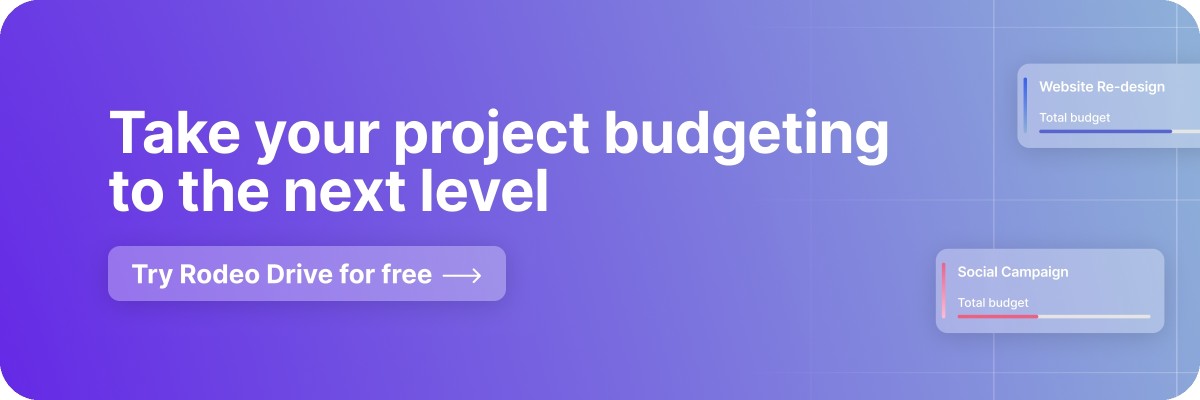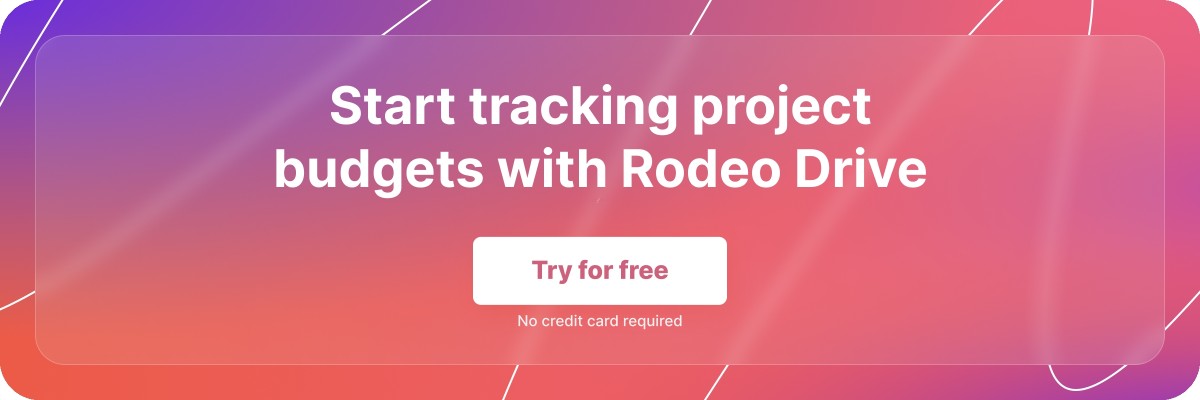8 Tips for Managing Project Budgets Like a Pro
A solid project budget is vital to successful project management. However, budgeting can be a real pain, especially with today’s fluctuating markets and cost prices.
A project is not static, but with the right tools and techniques, it's possible to control costs while delivering a successful project.
Earlier, we gave you a complete guide on how to build an effective project budget. This blog will continue to share the lowdown on the most popular budget management methods and some expert tips on creating project budgets like a pro.
After reading, you should have a few ideas for setting up a project budget and navigating changes. Let’s go!
The different project budget management methods
Overall, a project budget is an essential tool for project management, as it helps project managers to establish financial constraints, prioritize spending, identify potential issues, keep the project on track, communicate with stakeholders, measure performance, and make informed decisions about the project.
There are various methods and techniques that can be used to manage project budgets effectively.
Let’s explore the most popular project budget management methods and look at the advantages and disadvantages of each.
Also read: The Project Management Checklist: 12 Steps to Follow

Analogous budgeting
Analogous budgeting relies on historical data and similar past projects to estimate the budget for the new project.
This method is helpful for projects with fewer tasks or when detailed cost estimates are unavailable. One of the advantages of this method is that it is relatively fast and easy to use. It also provides a general idea of the budget, which can be refined as more information becomes available.
However, this method may not be as accurate as other budgeting methods. It may not fully represent the current project as it relies on data from other projects that might not be representable.
Incremental budgeting
Incremental budgeting helps project managers to prepare a new (annual) budget by taking last year’s budget and adjusting the figures, such as adding or subtracting a certain percentage. This straightforward method is typically used in environments where innovation or shifts in focus are unlikely to happen.
It is a useful technique for projects that are already ongoing or have long timelines.
As the project progresses, new information may become available that requires changes to the budget. Using this method can be more time-consuming and labor-intensive than other budget management methods as it requires accurate forecasting of future costs, which can be challenging for some projects.
Bottom-Up budgeting
When you total the budget estimates for each activity involved in a project to get your overall budget, you are following the bottom-up budgeting process. The technique gives individuals more say in how resources are allocated.
The bottom-up budgeting process typically starts by identifying all the tasks that need to be completed for the project and then creating detailed estimates of the time, resources, or costs for each task.
By breaking the project into smaller tasks and creating detailed cost estimates for each task, project managers can ensure that all costs are accounted for.
Creating a bottom-up budget can be quite time-consuming and labor-intensive than other budget management methods, as it requires detailed cost estimates for each task. It also requires accurate forecasting of future costs, which can be challenging for some projects.
Top-Down budgeting
From bottom-up to top-down budgeting: instead of having project managers define the budget, executives or high-level managers determine the budget based on overall company objectives.
This method is less granular but much faster than the abovementioned techniques.
It also provides a general idea of the budget, which can be refined as more information becomes available.
However, top-level management can be biased towards specific projects, or they rely heavily on historical data or past projects without considering changes in the market.
Zero-based Budgeting
When no framework or historical data is available, the project budget calls for a zero-based approach. All costs are scrutinized and justified, and the budget is built based on the current and projected needs of the project.
This method is helpful for projects that are very different from previous projects and can help ensure that all costs are justified and necessary.
However, it might take some time to get the budget right. Since there is no data, there is no backup, and it might ignite intense discussions, resulting in a budget based on opinions rather than needs.
Activity-based budgeting
Another top-down approach is activity-based budgeting. Managers define the project targets first. From there, they identify all the required activities to complete the project and then create detailed cost estimates for each activity.
By regularly monitoring the budget at the activity level, project managers can identify any budget overruns or underruns early on and take steps to correct them.
This method can be more time-consuming and labor-intensive than other budget management methods, requiring detailed cost estimates for each activity. The method that works best for your team will likely depend on your workflows and the size of your project.
Pro tip: don’t waste time manually totaling your expenses. Formulas can do the calculations for you. Download our project budget spreadsheet templates and try them out for yourself.
8 tips for managing project budgets efficiently
The budget affects most areas of the project. For example, creating a budget helps put a price on the project and determines the size of the team.
Budgets are easier to tackle with these eight tips:
Tip 1: Get your project budget approved and understood
Getting approval from internal and external stakeholders is the final step in building a budget. You want to ensure you get the buy-in from higher management and that your clients are willing to pay for the project before you and your team get underway.
Ask for feedback on specific tasks or phases of the budget to avoid any roadblocks ahead or missing deadlines. Also, this feedback helps you create more accurate budgets in the future.

Tip 2: Get buy-in from team members
Getting buy-in from your team for the project budget is crucial to ensuring that the project stays on track and is completed within the desired timeframe and budget constraints.
This is where soft skills like interpersonal communication skills come in handy.
Communicate the budget clearly to your team members and ensure that they understand the budget, how it will be used and how it will affect them while executing the project.
Make sure to explain the rationale behind the budget and how it will help the project to be successful. This will help them to understand why the budget is important and how they can contribute to its success.
During this meeting, you can also use data to back up the budget and show your team members how it compares to similar projects.
The most important element is: to be transparent about the budget and any changes made to it to avoid confusion and frustration.
We know that project budget management can feel overwhelming. Use our Ultimate Guide to Managing Projects Effectively to get started on your project manager journey.
Tip 3: Be flexible to budget changes
Now that you’ve got the project budget solidified, approved, and understood by internal and external stakeholders, it’s time to start planning and executing your project goals.
The project manager should try to stick to that budget as closely as possible. Always expect the unexpected: business needs can change, or the project scope shifts.
When those changes happen, make sure to address all the impacted elements of the project and bring the team up to speed as soon as possible.
A budget change process can look several different ways. For example, you might want to use a budget change request form before determining which area of the project the budget needs changing.
Tip 4: Host budget review sessions
During a project budget review, openly discuss what went well and what didn’t with the budget. You can plan this at any given stage, for example, after completing a project phase. Make sure to take notes that you can use as a reference to optimize future budgets or when similar projects arise.
A regular schedule for budget review sessions, such as monthly or quarterly, ensures that the budget is monitored regularly. Prepare an agenda for the budget review session, including items such as a review of the budget and a review of any changes that have already been made to the budget. Invite the right people to the budget review sessions, such as project team members, stakeholders, and budget holders.
After the meeting, the project manager updates the budget as needed based on the results of the review session. Assure the team that issues are being addressed by creating a structured follow-up document that everyone can access at any time.

Tip 5: Avoid unnecessary costs
It sounds very simple, right? Don’t spend the budget on unnecessary things. The budget is the amount that will be invoiced to the client, and every penny should be accounted for.
Take steps to avoid unnecessary project costs, such as cutting back on non-essential tasks or finding less expensive materials.
When the project is underway, and the required tasks are beginning to increase, be aware it’s not causing scope creep. Extra billable hours or shifting timelines can cause frustration with your team and causes shifts in the project budget.
Tip 6: Track expenses regularly
Tracking your actual budgeted expenses is one of the most important elements of ensuring you are not overspending.
Some project managers prefer to manually track their budgets in spreadsheets. However, this method will require double-checking for entry errors.
Implementing project controls process is another way to track expenses and avoid overspending. A team member could take on the role of project financial controller. This dedicated person could examine the data entries and identify issues.

Tip 7: Create project budget reports
Insights are gold to every project manager. Data allows you to see how accurate your budget was and how you can improve your project budget management for next time.
Without data, it’s nearly impossible to oversee the progress. There are multiple ways to set up reporting. Real-time reporting is based on up-to-the-minute information, while static reports hold historical data.
Ideally, you want to access insights and make data-driven decisions during every project phase to avoid any potential danger to your budget. Once the project is finished, stakeholders might require a detailed debrief of the budget spent, or the client might request a detailed overview of the billable hours.
Project management tools have reporting features that make it easier to see the overall project budget spending.
Our next tip might help you to streamline all project administration.
Tip 8: Use project management software
Many project budget software help set up a project budget in some way. Before you set eyes on a tool, consider which features you would need to make your project manager's life easier.
A platform that enables you to turn project budgets into client-ready estimates will help speed up the process of getting client approval on your budget while making the budget look presentable during meetings without extra effort.
As discussed in our previous tips, you never want to lose sight of the project costs.
Connecting your team’s tracked time to the project budget is extremely useful. Some tools automatically calculate the cost of time spent on each task according to each team member’s rate cards.
Invoicing is a necessary part of ensuring the company and your team members are compensated for their time and efforts. A solid software tool that allows you to invoice clients instantly based on the time logged, a percentage, or according to the project phase will save you a lot of manual labor.
Managing project budgets in real-time with Rodeo Drive
Rodeo Drive is an all-in-one project management tool with every feature you need to build a robust project budget.
Our platform ensures you follow through with all your project budget management steps, saving you time through every project stage.
By bringing all necessary project management features together into one tool, customers like BAIT Studio have discovered that using Rodeo Drive cuts down their project management tool costs by 50%.
Now that we’ve given you tips on how to manage a project budget like a pro, it’s only right that we share what you can do with our platform.
These are some of the platform’s beloved features:
Break down your budget into phases, activities, and tasks
A project can’t start without a detailed budget. Rodeo Drive prompts users to start all projects with a budget. Users can divide their projects into phases and add activities and tasks within each of those phases.
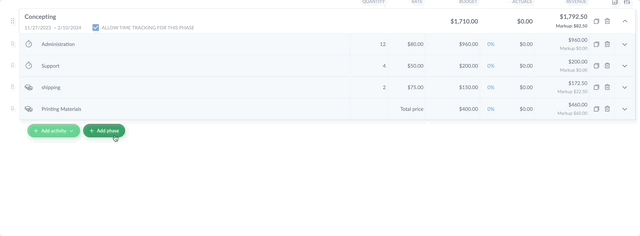
By adding either time activities or expenses to each phase, Rodeo Drive will automatically calculate how much each phase will cost in addition to totaling the cost of the overall project.
If you’re working on a project that resembles a project you’ve previously completed, Rodeo Drive allows you to copy your old budget’s framework to your new project, saving you time.
Turn your project budget into client-ready estimates
Once you’ve built your budget, you can create and send an estimate in just a few clicks. Budget approved? Get going, record your hours, and plan your project's timeline.

Effortlessly track time
Time tracking can be a hassle and frustrating if you have to remind your team to log their hours. Rodeo Drive makes it easy by allowing your team to track time in two ways: start the stopwatch via the planner when you begin working on a task or simply add a timecard later.
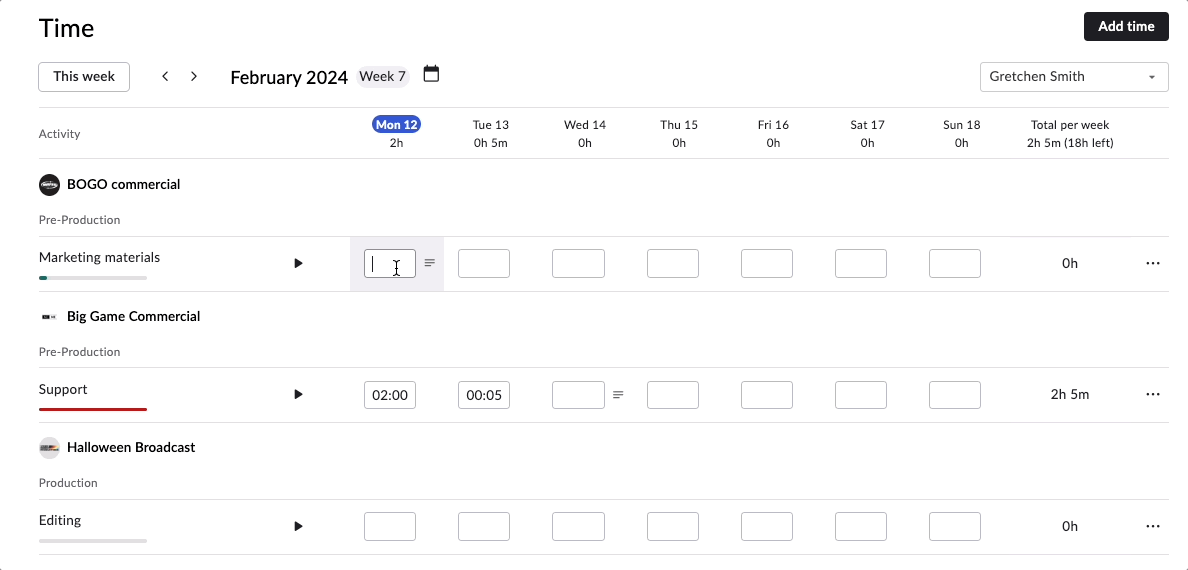
Every time entry recorded in Rodeo Drive connects to a budget activity, meaning your budget will automatically update as you track time, and you avoid overspending.
Access insights
Rodeo Drive’s features are interconnected, enabling you to access insightful reports on your project profitability, employee productivity, and time registration.
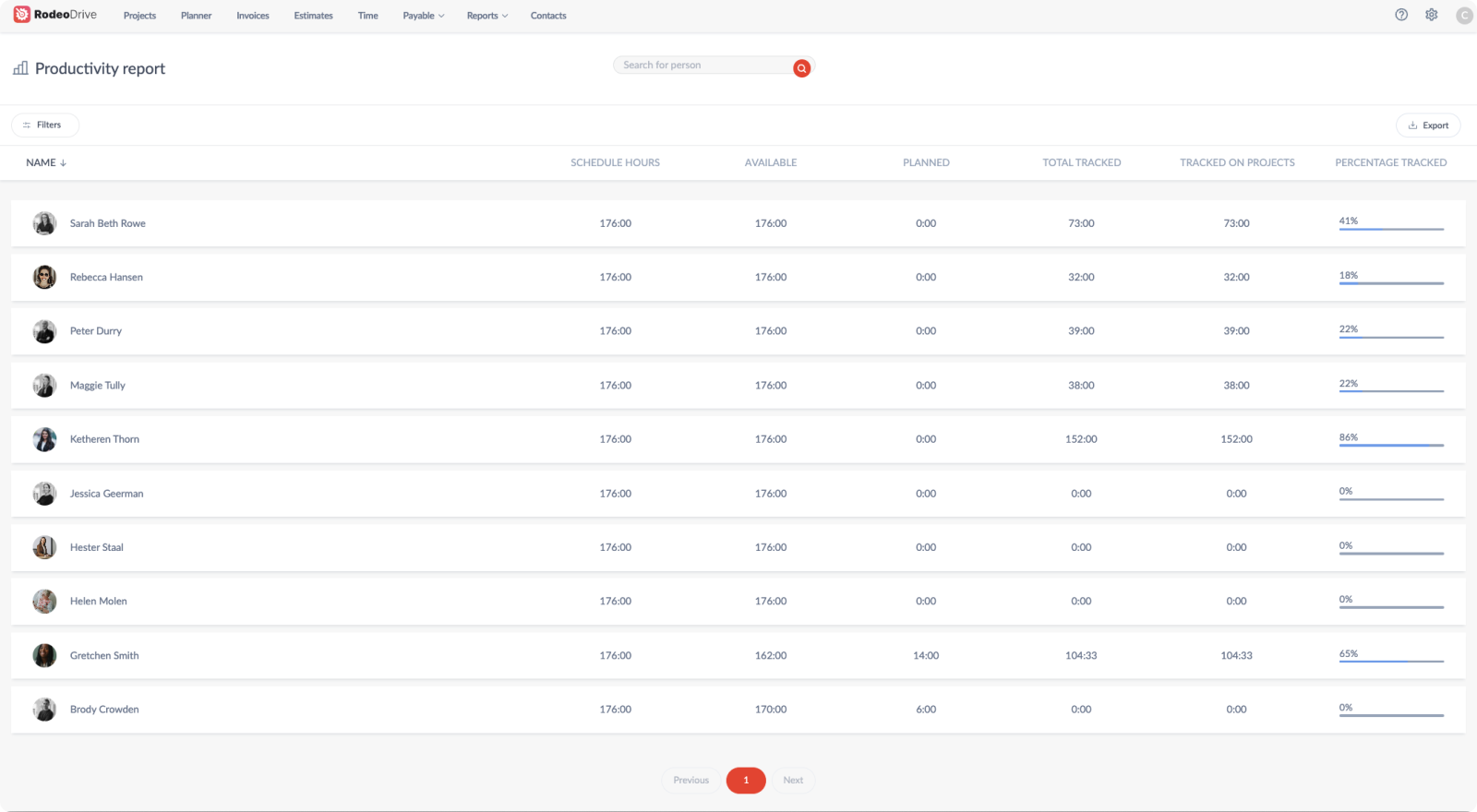
These insights allow you to see how accurate your budget was and make data-driven decisions that improve your profitability for next time.
Additional features:
- Invoicing
- Task management
- Expense tracking
- Capacity planning
- QuickBooks (US)
- Xero (UK) integrations
Sign up for free to discover how Rodeo Drive can help you manage your budgets. You don’t even need to enter your credit card to get started.





